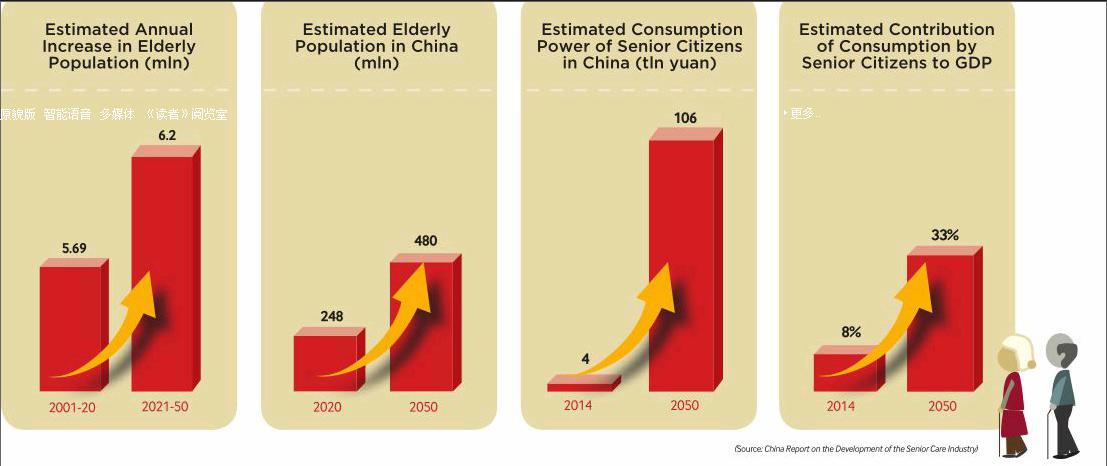Hi Ho, Silver!
2014-11-10ByWangJun
By+Wang+Jun

the proportional growth of Chinas elderly population is projected to stimulate consumption of more than 100 trillion yuan ($16 trillion) over the next 35 years, according to the China Report on the Development of the Senior Care Industry released by the China Research Center on Aging (CRCA).
The report claims that China is now entering the primary stage of becoming an aging society, and in years to come will constitute the single largest product and service market for senior citizens in the world. A consumer base of this magnitude will attract huge amounts of capital to enter what has in China been dubbed the“silver hair” industry.
Growing market
It is estimated that by 2050, the world will have an elderly population totaling some 2.02 billion and nearly one quarter of them will live in China. From 2014 to 2050, the domestic market for providing services and products for the countrys senior citizens will soar from 4 trillion yuan ($650.41 billion) to 106 trillion yuan($17.24 trillion), and its contribution to GDP will rise from 8 percent to 33 percent.
According to the report, Chinas silver hair industry on the whole enjoys a sound policy environment for development. As market demand continues to grow, private investors are increasingly willing to take a gamble, bringing unprecedented growth opportunities to the industry. The market for home appliances designed for senior residents is flourishing, the sector of the services catering to senior citizens is fast becoming an investment hotspot and in real estate, the construction of housing for senior residents is rapidly on the rise.
The report, however, also claims Chinas silver hair industry is facing a glut of issues, including inadequate effective demand, an unbalanced industrial structure, slow rates of improvement in industrial organizations and uncertain industrial policies.
Against the backdrop of economic restructuring, transformation of government functions and strengthened government support, Chinas silver hair industry, as a basic pillar and strategic industry in an aging society, is both an integral part of the future macroeconomy of China and a strategic choice to address the challenges brought by the aging population.
“China must seize the opportunities for the development of the senior care industry, create effective rigid demand as far as possible and formulate policies to improve the industry as a matter of urgency,” said Wu yushao, Deputy Director of the China National Committee on Aging.
“It should also accelerate the development of industrial organizations, establish service networks for senior residents and set up national research and development bases for the industry,” Wu added.
The silver hair industry comprises four major areas: financing, appliances, services and real estate.
According to the report, by 2020, China will have 29 million people aged 80 and above, and the group will reach its peak in 2054, standing at a considerable 118 million.
Therefore, the senior care industry must focus on this section of the population. “The number of senior citizens unable to take care of themselves will also increase dramatically, reaching 47 million by 2020 and surpassing 100 million in 2053. This will engender a huge market for the industries of appliances, services and real estate,” said Dang Junwu, Deputy Director of the CRCA.
The number of empty nesters and the childless is also growing, and may reach 79 million by 2050. “Demand for services by such elderly citizens will be particularly robust, and this will stimulate development of the industries of appliances and real estate for the elderly. Providing salable products and services for them will be a large market to be developed,”said Dang.
According to the report, there will be a large increase in demand for healthcare services by senior citizens. It is estimated that among all the senior residents, the number of chronically ill will rise from 110 million to 300 million in 2050, and the healthcare consumption of senior citizens will account for at least 5 percent of the countrys GDP. Behind these figures lies a huge potential healthcare consumption market.
The report states that in the future Chinas aging population will be better educated than previous generations of seniors; therefore, the design of products as well as supply of services and real estate must incorporate to a greater degree the cultural tastes of senior citizens. “This will also boost upgrading of the senior care industry, which may bring unlimited business opportunities,” Dang added.
Financial innovation
Among the four categories of the senior care industry, financing should be accorded the most precedence.
In Western countries, senior care financing is an important part of the modern financial system, and developing senior care financing represents a priority for the financial industry.“For instance, in the United States, among the 6.21 million people working in the financial industry in 2012, 60 percent were engaged in senior care financing,” Dang said.
At present, Chinas senior care financing industry is facing problems such as a low level of awareness of the financial needs of ordinary people, a lack of supply to meet the present demand for senior care financial products and an underdeveloped senior care financial market. Therefore the industry must change their strategies and establish a new type of financial system appropriate to the senior care economy.
“In the long term, China is less prepared in the financial sector for the challenges of the aging population,” said Wang Haitao, Deputy Director of the Strategic Institute of the CRCA, adding that improving the senior care financial system not only serves to meet the demand for development of the senior care industry, but also an important measure to consolidate economic reform, reinvigorate the national economy and build new engines for economic growth.
Despite the advanced years of its target market, Chinas senior care financing is still in its infancy. Banking deposits are still favored by senior citizens over financial products, despite the fact that this remains an ineffective investment choice, which reflects the dearth of attractive senior care financial products.
The report forecasts that as the Chinese economy further grows, banking, insurance, investment funds and securities companies have become aware of the opportunities and challenges brought by the aging population.
“The industry must reorganize various resources and diversify financial products targeted at the elderly, so as to establish a diversified, multi-level, consumer-oriented and balanced structure for a sustainable senior care financial industry and facilitate the sound development of the Chinese financial industry in an aging society,” said Wang.
